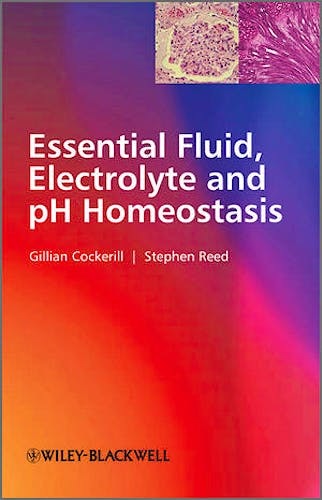

No hay productos en el carrito



Essential Fluid, Electrolyte and Ph Homeostasis
Cockerill, G. — Reed, S.
1ª Edición Noviembre 2011
Inglés
Tapa blanda
360 pags
1100 gr
null x null x null cm
ISBN 9780470683064
Editorial WILEY
LIBRO ELECTRÓNICO
-5%
49,91 €47,41 €IVA incluido
47,99 €45,59 €IVA no incluido
Acceso On Line
Inmediato
Description
This textbook provides a unique, pocket-sized, self-directed study guide to fluid, electrolyte and acid base homeostasis for undergraduate biomedical science, pharmacology, medical and allied health students. It details the chemical (mostly ionic) composition of body fluids, explains how abnormalities arise, what laboratory tests can be used to identify and analyze the cause of these disorders and shows how normality can be achieved to maintain health.
Table of Contents
- List of figures
- List of tables
- Preface
- Acknowledgements
Part 1: Background theory and basic concepts.
- Section 1.
- Introduction and overview
- Water
- Solutions: concentrations and colligative properties of solutes
- Self-assessment exercise 1.1
- Acids and bases
- Buffers and the Henderson-Hasselbalch equation
- Self-assessment exercise 1.2
- Body fluids and their composition: overview
- Fluid balance: (a) between fluid compartments and (b) intake and loss
- Ionic composition and electrical neutrality
- Water and ion distribution between compartments 1: Physical chemistry
- Water and ion distribution between compartments 2: Physiology
- Osmoregulation: solvent and solute balance
- Self-assessment exercise 1.3
- Summary of Part 1
- Answers to Part 1 self-assessment exercises
Part 2: Fluid and electrolyte homeostasis.
- Normal physiology
- Fluid translocation: plasma to ISF and ISF to ICF
- Renal function: a brief overview
- Renal regulation of blood composition
- Self-assessment exercise 2.1
- Minerals: key roles in physiology and metabolism
- Sodium and potassium
- Sodium and water homeostasis: renal regulation of blood pressure and blood volume
- Calcium and magnesium
- Iron
- Selected trace elements: Mn, Co, Se and S
- Anions: bicarbonate, chloride, phosphate and proteins
- Self-assessment exercise 2.2
- Laboratory measurements 1: Osmometry
- Laboratory measurements 2: Ion selective electrodes (ISEs)
- Laboratory measurements 3: Calcium, magnesium, vitamin D, phosphate and iron
- Laboratory measurements 4: Miscellaneous methods for clinically useful analytes
- Self-assessment exercise 2.3
- Disorders of fluid and electrolyte balance
- Introduction
- Principles of data interpretation
- Sodium, protein and water
- Hypernatraemia
- Hyponatraemia
- Disturbances of potassium homeostasis
- Hyperkalaemia
- Hypokalaemia
- Disturbances of calcium or magnesium balance
- Disorders of iron homeostasis
- Self-assessment exercise 2.4
- Summary of Part 2
- Answers to Part 2 self-assessment exercises
Part 3: Acid-base homeostasis.
- Normal physiological processes
- Acidity, pH and buffers: recap of some basic chemistry
- Some worked example calculations
- Self-assessment exercise 3.1
- Homeostasis and the 'daily acid challenge'
- Physiological buffering
- The role of the kidney in acid-base homeostasis
- Respiration: gas pressures and breathing
- The role of red cells: gas carriage by haemoglobin
- Self-assessment exercise 3.2
- The liver and gastrointestinal tract in acid-base homeostasis
- The ‘traditional’ versus the 'modern' view of acid-base homeostasis
- Stewart’s three independent factors
- Laboratory measurement of pH, PCO2 and bicarbonate
- Acid-base disturbances
- Classification of primary changes based on pH and aetiology
- Overview of mechanisms
- Physiological correction of primary disturbances
- Check the data
- Self-assessment exercise 3.3
- Non-respiratory (metabolic) acidosis
- Metabolic acidosis: detailed case studies
- Non-respiratory (metabolic) alkalosis: overview
- Non-respiratory (metabolic) alkalosis: causes
- Self-assessment exercise 3.4
- Respiratory disorders: overview
- Physiological consequences of respiratory disorders
- Respiratory disorders: case studies
- Summary of Part 3
- Answers to Part 3 self-assessment exercises
- Appendix
- Index
© 2025 Axón Librería S.L.
2.149.0